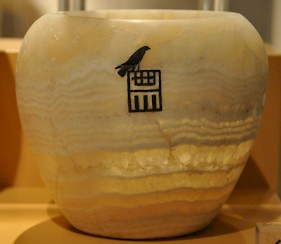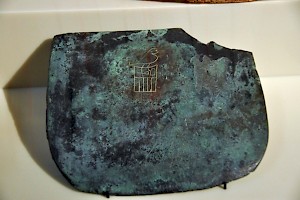Serekh
Serekh: a square cartouche, used by the Egyptians to write the name by which their kings wanted to be known.

In hieroglyphic texts, you often see signs enclosed in oval shapes, which are called cartouches. They are quite famous because the discovery that characters thus enclosed were alphabetic letters representing the name of Egyptian kings was the crucial first step toward deciphering the ancient Egyptian writing system.
Less well-known are the square cartouches. Egyptian rulers had more than one name: a personal name and several ones taken at their installation. During the first dynasties, the ruler's most important name was written in the square serekh, which means "that which makes known", i.e., the chosen identity of the ruler.
An example can be seen on the alabaster cup of King Djer, Narmer’s second successor. In the lower register, we can recognize a stylized representation of the façade of a palace. In the upper register, we can read the royal name, Djer. Finally, the square is surmounted by a falcon.
We do not have religious literature from this early age, but when we are able to read sacred Egyptian texts, this bird represents the god Horus, who represented cosmic order and protected the king. It is likely – although we cannot prove it – that the falcon on the serekh represented the same deity, and therefore, the royal name inside the serekh is called his "Horus name".

Only king Peribsen, one of the rulers of the Second Dynasty, replaced the falcon with the animal that is usually associated with the god Seth, who represented chaos and was the opponent of Horus. His successor Khasekhemwy had a serekh with both animals. After these two unusual kings, the rulers of the Third Dynasty returned to the falcon serekh, while the kings of the Fourth Dynasty no longer stressed their Horus names, and instead focused on the names that were written in cartouches.
There has been no shortage of explanations for these changes, but in fact we just don’t know why Peribsen and Khasekhemwy preferred another animal, and why the rulers from the Fourth Dynasty on preferred other names.